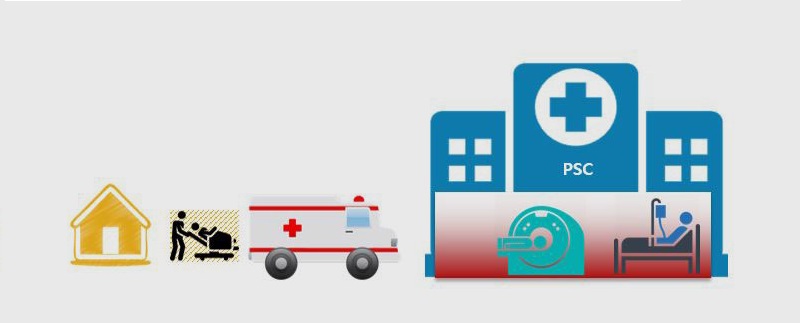The analysis of Medicare patients shows that those treated at recently certified centers fare the best.

The process of undergoing certification as a primary stroke center (PSC) appears to improve systems enough to have a positive impact on patient outcomes, according to an analysis published online ahead of the September 2017 issue of Stroke. Getting certified could help some hospitals overcome the clinical disadvantages associated with smaller size, study authors suggest.
Ken Uchino, MD (Cleveland Clinic, Cleveland, OH), and colleagues analyzed Medicare data on nearly 2 million fee-for-service beneficiaries aged ≥ 65 years who were hospitalized between 2009 and 2013 for ischemic stroke. They divided the hospitals in which patients were treated into one of three groups:
- New primary stroke centers: hospitals that received their primary stroke center certification between 2009 and 2013 (n = 634)
- Existing primary stroke centers: hospitals that were certified as a primary stroke center before 2009 (n = 785)
- Non-stroke centers: hospitals that were never certified as a primary stroke center (n = 2,640)
“We lumped several types of stroke center certification into one,” Uchino explained to Neurovascular Exchange in an email. “There is PSC and the more recent Comprehensive Stroke Center (CSC) certification. Since CSC is more recent and all CSCs have PSC-level function and certification, we analyzed as [them all as] PSCs.” The researchers also considered hospitals that received stroke certifications from alternative entities, such as state health departments and other for-profit and nonprofit organizations, as primary stroke centers for the sake of their analysis.
Existing primary stroke centers had a larger total number of beds and higher annual stroke admission rate than new primary stroke centers (P < 0.0001). Despite their smaller size, after controlling for patient demographics and comorbidities, new primary stroke centers had lower in-hospital and 30-day mortality compared with existing and non-stroke centers. They also had lower 1-year mortality compared with non-stroke centers.
Mortality Risk at New Primary Stroke Centers (OR/HR, 95% CI)
|
|
vs Existing Centers |
vs Non-Stroke Centers |
|
In-Hospital |
0.862 (0.817-0.910) |
0.894 (0.848-0.943) |
|
At 30 Days |
0.981 (0.968-0.993) |
0.904 (0.892-0.917) |
|
At 1 Year |
NS |
0.907 (0.898-0.915) |
In addition, existing primary stroke centers had lower adjusted 30-day mortality (HR 0.922, 95% CI 0.911-0.933) and 1-year mortality (HR 0.900, 95% CI 0.892-0.907) than non-stroke centers.
“We expected that certified stroke centers would have lower mortality than non-PSC hospitals,” noted Uchino. “We did find that. But I didn’t expect newly certified stroke centers to perform better than existing ones.”
Joseph Broderick, MD (University of Cincinnati, Cincinnati, OH), commented on the study for Neurovascular Exchange in his role as an American Heart Association and American Stroke Association national volunteer. He pointed out in an email that mortality began to diminish at new primary stroke centers in the years leading up to certification. “The data appear to show that even the preparation for obtaining certification . . . actually changed outcomes,” he wrote. “Thus, focusing on the problem is the beginning of the solution. After certification, there wasn’t much additional change.”
A Lesson to Learn
Uchino believes non-stroke centers can learn from these findings. “Certified stroke centers, on average, are larger than hospitals that are not stroke centers, but clearly there are small hospitals that are certified,” he pointed out. “Adjusted for hospital size, stroke centers still have lower mortality. Therefore, these hospitals without certifications should consider what they need to do to become stroke centers.”
He and his team are currently looking into exactly why the primary stroke centers appear to have better outcomes. One possibility, he said, is that certification offers increased standardization of care, which makes it more reliable. But this does not explain all their findings. For instance, Uchino said they remain puzzled as to why the 1-year mortality risk for stroke declined dramatically from 2009 to 2013 at both primary stroke centers and non-stroke centers.
Broderick noted that “focus on identification of patients who are candidates for acute treatment with tPA and attention to speed of treatment with tPA improve outcomes. Also, the focus on other [Joint Commission] criteria that ensure proper assessment of swallowing, prevention of deep venous thrombosis, proper use of antithrombotics, rehabilitation, smoking cessation, and use of statins not only improves care in hospital but decreases risk of subsequent stroke and other negative outcomes in the following year.”
The Centers for Medicare & Medicaid Services is working on a more accurate comparison of outcomes that will include assessment of NIHSS stroke severity upon arrival at hospital, he added.
“It is highly likely that more severe patients come to larger primary stroke care hospitals than smaller, newer ones,” Broderick pointed out. In addition, smaller non-primary stroke centers located in rural areas must treat patients with severe strokes despite having more limited resources to invest in the certification process. For such centers, telemedicine may help them benefit from the expertise located in comprehensive stroke centers, he suggested.
What remains clear is that stroke patients fare better at stroke centers. “This is going beyond this particular paper,” said Uchino, “but I think we will see that it becomes more important to be seen at expert centers, including CSCs. Stroke centers are just one part of a better and reliable system of care for stroke patients that we are trying to create. We will be analyzing the effect of increase in CSCs and interventional therapies in the future.”
Source:
Man S, Schold JD, Uchino K, et al. Impact of stroke center certification on mortality after ischemic stroke: the Medicare cohort from 2009 to 2013. Stroke. 2017;Epub ahead of print.
Disclosures:
- Uchino reports no relevant conflicts of interest.
- Broderick reports that his department has received monies for his role on Executive Committee for the PRISMS Trial funded by Genentech.